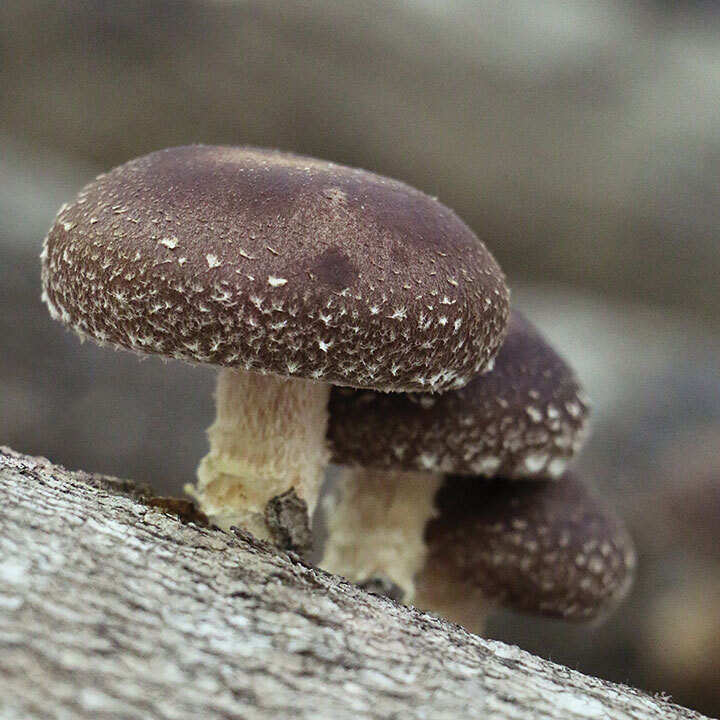
Shiitake mushrooms grown on logs can be highly productive. Good quality logs can fruit for up to 8 years. Inoculating logs is simple and straightforward. Maintaining and managing logs is a matter of moisture management and patience. Before you begin, please be sure you have good quality logs to make the best possible Shiitake growing experience. Follow the six steps below for inoculating and managing your Shiitake logs.
1. Cut the logs (3-8˝ diameter x 36-40˝ length)
Healthy, living trees should be cut during the dormant season and rested a minimum of 2 weeks prior to inoculating. This allows time for the tree's defense system to die back. Protect the logs from drying out by storing them low to the ground (but out of the soil and leaf layer), out of the sun and wind, and where they can receive natural rainfall. Logs can be rested until inoculation for longer than 2 weeks, however there is increased risk of contamination and losing vital log moisture beyond 8 weeks.
NOTE: Larger logs may be used, but keep in mind that larger logs take longer to produce your first crop of mushrooms.
2. Drill the holes
Drill the holes to a 1˝depth following the diamond pattern shown for roughly 50 holes per log. Drill around the entirety of the log. Plug spawn requires an 8.5mm (5/16˝) drill bit, and sawdust spawn typically requires a 12mm (7/16˝) drill bit. Drill holes all the way around the log.

3. Inoculate and seal with wax
Plug spawn: Use a hammer and gently tap in one plug per hole so it is flush with the surface of the log.
Sawdust spawn: Break apart the spawn and inject it into each of the holes, typically with the use of an inoculation tool.Wax the holes as the logs are inoculated to protect the spawn from drying out and reduce the risk of contamination. Be sure the hole is completely sealed. Waxing the ends of the logs is not necessary. Sealing plug spawn with plug wax is an easy alternative to melting cheese wax and is easily applied using your finger as if you're applying lip balm over the end of the plug and hole opening. Hot wax is faster to apply and works better with sawdust spawn. Consider using wax daubers or the Okuda wax applicator. The flash point of cheese wax is 450°F. Do not overheat the wax! Turn down the heat if the wax begins to smoke.
5. Incubate logs and manage for moisture
Once inoculated, place your logs in a shaded area, protected from the sun and wind, low to the ground (we lay them on pallets or poles), and where they can receive natural rainfall. (Note: we recommend covering your logs with some permeable fabric, pine boughs, or netting if wood peckers are active in your area as they have been known to take spawn out of drill holes). Maintaining moisture during this phase is the most critical step to Shiitake production success. We recommend your logs receive 1˝ of rain per week. If the weather is not cooperating, you may need to sprinkle your logs with a hose. Logs will begin producing mushrooms when spawn run is close to complete and the conditions for fruiting are ideal. This timing varies, so keep an eye on your logs. Once fruiting commences, they can be re-stacked into a different configuration to make harvest easier.
6. Harvesting mushrooms
Monitor your logs as they fruit. Mushroom development can happen very quickly and it is best to pick them when the edges of the cap are still curled under. Over mature mushrooms do not store as long. Simply grab the mushroom, twist, and pull it off the log. Store your harvest in the refrigerator up to 14 days in a sealed storage container.
Force-fruiting Shiitake Logs (optional)
Force fruiting or "shocking" Shiitake logs is a strategy to achieve scheduled mushroom production. We recommend waiting to force fruit until early summer after the logs have naturally fruited and the weather is consistently warm. Shock Shiitake logs by submerging them in cold water (at least 20°F colder than air temperature) for 12-18 hours, then set them up for fruiting. Mushrooms develop 5-14 days after soaking depending on the temperature. The use of fruiting blankets or garden row covers to protect the crop is recommended. This process can be repeated on an 8-10 week rotation during the growing season. Note that the Shiitake strains Miss Happiness™, Bellwether™, Snow Cap™, and Jupiter™ do not respond well to force fruiting.
